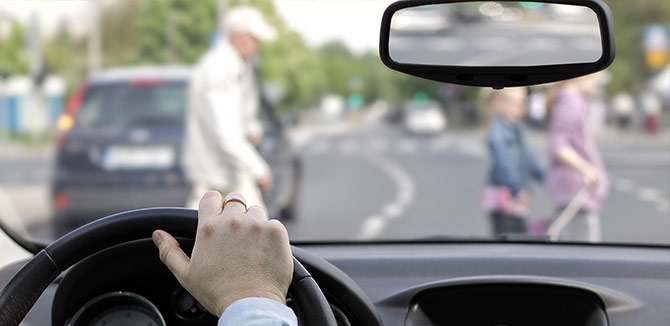Everyone’s done it -- that unconscious little pause when you come to a stop sign. With a quick look around, you roll on through, hoping you don’t get caught in a traffic violation. We all know rolling stops are illegal, but how much harm can you really do at such a slow speed?
In this article, we’ll explain why this very common driving behavior is so risky, and what tools fleets can use to encourage more drivers to make complete and full stops.
Reality check: The risks of rolling stops
Rolling stops are more dangerous than anyone might suspect. According to the U.S. Department of Transportation Federal Highway Administration, one-quarter of traffic fatalities and roughly half of all traffic injuries are attributed to intersections.
Additionally, in an estimated 787,236 intersection-related crashes studied by the National Highway Traffic Safety Administration (NHTSA):
- about 31% of those intersections were controlled by at least one stop sign.
- over 96% of the critical reasons for the intersection-related crashes were attributed to the drivers
- 55% were recognition errors (inattention, internal and external distractions, inadequate surveillance, etc.)
- about 29% were decision errors (illegal maneuver, such as a rolling stop, speeding or aggressive driving, false assumption of other’s actions, etc.)
This footage shows just how quickly things can go wrong after a rolling stop:
Keep in mind that even at low speeds, a pedestrian is no match against a car or vehicle of any size. According to the NHTSA, 57% of fatal crashes in 2018 involved only one vehicle; and, on average, a pedestrian was killed every 88 minutes in traffic crashes in 2017.
“There are people, vehicles, bikes, and even animals passing through intersections at all angles. One seemingly harmless roll through a stop sign could be the next time someone else has unexpectedly entered the same intersection,” said Del Lisk, vice president of safety services for Lytx®.
Why do drivers do it?
Even though stopping is the safe and legal thing to do, there are a variety of reasons why drivers decide to keep the wheels turning:
- Tight deadlines: Drivers are under increasing pressure to make on-time deliveries, perform multiple services a day, and keep up with the surge in e-commerce shipping. Rolling through a stop sign can inaccurately seem to add up in time saved.
- Distractions: If drivers are distracted and don’t see an oncoming stop sign, they might worry that it would strain the brakes or damage the cargo to bring their fully loaded vehicle to a complete stop.
- Road fatigue: Drivers spend days on the road, away from their families. They can often rush on their routes simply because they want to be home faster.
- Bad habit: When a driver rolls through a few stop signs without any consequences it unconsciously reinforces the continuation of this behavior.
In other words, drivers aren’t rolling through stops for the thrill of it. And these professionals will make a different decision when they fully understand the risks, which can be accomplished with the help fleet safety technology.
MV+AI can help put a stop to rolling stops
Lytx technology incorporates advanced machine vision (MV) and artificial intelligence (AI) to analyze driver behavior and the surrounding environment. Specific behaviors—like rolling a stop sign, following too closely, or texting while driving—“trigger” the technology to flag the event.
To explain how the system works in simplest terms, think of MV as a set of eyes and AI as a brain. MV recognizes and catalogs objects, while AI combines that information (along with other data like speed and GPS) to assess the level of risk.
For example, when a vehicle approaches an intersection, the MV technology will scan and recognize the stop sign. The system then collects speed data from the vehicle to detect if the driver came to a complete stop. If they didn’t, the Lytx system can tag it as well as capture a video clip that can be reviewed later by the driver or a supervisor.
Ultimately, capturing events and driving data with MV+AI technology can give fleets an expanded view of risk by pinpointing specific behaviors. The insights can show a driver if they need to work on changing a behavior, like rolling stops. And fleet leaders will also know if certain risky behaviors are appearing among all drivers and adapt their safety programs accordingly.
“Conventional in-cab video was designed to trigger G-force-related events, such as swerving, hard braking, or an impact,” says Lisk. Video capture of a rolling stop would only occur as a byproduct of another, more abrupt event, which made the majority of rolling stops difficult to detect.
Now, with the sensitivity of MV+AI in Lytx fleet safety solutions, drivers can accurately identify how often rolling stops and other risky driving behaviors occur while they’re on the road. Knowing the frequency and risks, they’ll be positioned to correct their behaviors and improve fleet safety.
See it in action
To really understand how powerful Lytx MV+AI technology is for identifying risky behaviors like rolling stops or distracted driving, schedule a demo. In just about 30 minutes, you can see it in action.
